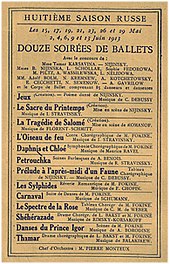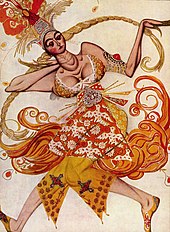Ballets Russes




The Ballets Russes [ balɛʀys ] are considered to be one of the most important ballet ensembles of the 20th century. They were founded in 1909 by the Russian impresario Sergei Djagilew and initially worked under his direction in Paris, where they made an inspiring first appearance on May 19, 1909. In 1911 the company took its seat in Monte Carlo. Dyagilev's goal was to make Russian art known in Europe. He followed the principle of L'art pour l'art , i.e. art for its own sake, without any sought-after reference to the political reality of its time.
The company's choreographers such as Michel Fokine , Léonide Massine and George Balanchine laid the foundations for modern ballet , while dancers such as Vaslav Nijinsky and Anna Pawlowa became international stars of the ballet scene. After Dyagilev's death in 1929, the company was disbanded. The Ballets Russes de Monte Carlo was formed as the successor company .
Development and important works
Djagilev had already arranged a large exhibition of Russian art in the Grand Palais in 1906 and a series of concerts with Russian compositions at the Paris Opera in 1907. In 1909 he presented various ballets by Michel Fokine at the Théâtre du Châtelet in Paris , including Le Pavillon d'Armide , Le Festin , Les Sylphides and Cléopâtre . The pieces were danced by famous ballet stars of the St. Petersburg Mariinsky Theater such as Tamara Karsawina , Vaslav Nijinsky and Anna Pawlowa.
In 1910 Djagilew founded a permanent theater company with dancers from Saint Petersburg and Moscow , which was based in Saint Petersburg until 1914. On their tours, the Ballets Russes quickly achieved world fame with Michel Fokine's naturalism- inspired choreographies. Pieces such as L'Oiseau de Feu and Petrushka based on the music of Igor Stravinsky were part of the repertoire of several tours in the period that followed.
Famous stage and costume designers of the Ballets Russes were Léon Bakst , who was inspired by Art Nouveau , and Alexandre Benoîs, who was more inclined to classical balance . With their entire performance aesthetic, the Ballets Russes were under the influence of Russian symbolism. The mechanistic art tendencies after the turn of the century were countered here with a luxurious, luxurious style oriented towards the expression of emotion.
Vaslav Nijinsky's choreography for Le Sacre du Printemps, on the other hand, which was created for the Ballets Russes in 1913, already pointed far beyond this framework. It caused a scandal among audiences used to the movements of classical ballet or narrative ballets of the 18th century. With its geometric-abstract dance figures, this choreography is generally considered to be the beginning of modern ballet. Nijinsky's choreography to L'Après-midi d'un faune based on the music of Claude Debussy also set new standards with the directness of the presentation.
In 1914 Dyagilev turned away from the Saint Petersburg School and began to promote cooperation with visual artists - ballets were created with a strong emphasis on the stage design . Léonide Massine's works such as Parade from 1917 are clearly influenced by this: Jean Cocteau , Eric Satie and Pablo Picasso created the libretto, music and stage design for this. At Zéphyr et Flora , Vladimir Dukelsky (Vernon Duke) was responsible for the music and Georges Braque for the stage design.
With Bronislava Nijinska , Nijinsky’s sister, and George Balanchine as choreographers, neoclassical trends made themselves felt in the ensemble by 1922 at the latest. Balanchine endeavored to achieve the greatest possible unity of music and dance and avoided any dramatic action. His Apollon musagète from 1928 is considered to be style-forming.
The Ballets Russes were an influential cultural phenomenon in their day that made fashion. The star cult around the great dancer Nijinsky, the often exotic-erotic ballet acts and the sensual-fantastic costumes kept the public imagination very busy. Every evening at the theater was a sold out event, the women dressed “à l'orientale”, with turbans, feathers and darkly made-up complexions, and people went out to admire the “god of dance”, Vaslav Nijinsky.
In artistic work, the Ballets Russes exerted a direct influence on the American Ballet Theater and the company of the New York City Ballet , where Balanchine continued his work.
literature
- John E. Bowlt et al. a. (Ed.): A Feast of Wonders. Sergei Diaghilev and the Ballets Russes . Skira, Milan 2009, ISBN 978-88-572-0090-3 (catalog of the exhibition of the same name, Nouveau Musée National de Monaco - Villa Sauber, July 9 to September 27, 2009).
- Petra van Cronenburg: The fascination of Nijinsky. Approaching a Myth . Monsenstein and Vannerdat, Münster 2011, ISBN 978-3-86991-362-9 .
- Robert C. Hansen: Scenic and Costume Design for the Ballets Russes . UMI Research, Ann Arbor, Mich. 1985, ISBN 0-8357-1681-3 .
- Joachim Homann: Le coq d'or. Natalia Goncharova's Designs for the Ballets Russes . University Press, Cambridge, Mass. 2003 (catalog of the exhibition of the same name, Busch-Reisinger Museum , May 10 to August 24, 2003).
- Наталия Лапшина: Мир искусства. Искусство, Москва 1977.
- André Levinson: Bakst. The story of the artist's life . Bayard Press, London 1920.
- German: Ballets Russes. The Art of Léon Bakst (The bibliophile paperbacks; 666). Harenberg, Dortmund 1992, ISBN 3-88379-666-2 (reprint of the Berlin 1922 edition).
- Jane Pritchard: Diaghilev and the Golden Age of the Ballets Russes 1909-1929 . V&A Publishing, London 2010, ISBN 978-1-85177-613-9 (catalog of the exhibition of the same name, Victoria and Albert Museum London, September 25, 2010 to January 9, 2011).
- Yvgenia Petrova (Ed.): The World of Art . Palace Editions, Bad Breisig 1998, ISBN 3-930775-53-0 .
- Alston Purvis et al. a. (Ed.): The Ballets Russes and the Art of Design . The Monacelli Press, New York 2009, ISBN 978-1-58093-254-7 .
Web links
- Literature by and about Ballets Russes in the catalog of the German National Library
- Diaghilev's Ballets Russes History
- Les Ballets Russes - Reloaded at the Semper Opera in 2012
Individual evidence
- ^ Nijinsky . ( Page no longer available , search in web archives ) Info: The link was automatically marked as defective. Please check the link according to the instructions and then remove this notice. Institut français in Germany
- ↑ Châtelet: l'historique . Théâtre du Châtelet
- ^ Horst Koegler , Helmut Günther : Reclams Ballettlexikon. Philipp Reclam jun. Stuttgart 1984, p. 40.
